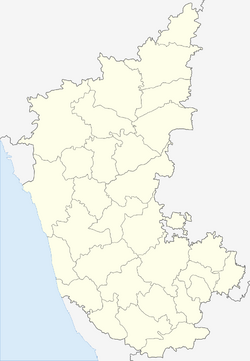| ||||||||||||||
| Chikkaballapur district Chikballapur |
|
|---|---|
| — district — | |
| The Bhoganandishvara group of temples at the foot of Nandi hills | |
| Coordinates: Coordinates: | |
| Country | |
| State | Karnataka |
| District | Chikballapur District |
| Government | |
| • District Collector | |
| Time zone | IST (UTC+5:30) |
| PIN | 562 101 |
| Telephone code | 08156 |
| Vehicle registration | KA-40 |
Chikballapur district is a newly created district in the state of Karnataka, India. It was carved out of the existing Kolar district by moving the taluks of Gauribidanur, Gudibanda, Bagepalli, Chikballapur, Sidlaghatta and Chintamani into the new district.
Chikballapur is the District Headquarters of the newly created (2007 August) District of Chikballapur. The town is approximately 50 km (31 mi) north of Bangalore, the silicon plateau of India. The north-south National Highway NH 7 goes through the town. The town contains a bus headquarters, railway station, and is the origin of several national Highways. As a result, it is a key transport link in North Bangalore. The town is within 3 km (1.9 mi) of Muddenahalli (the birthplace of eminent engineer and statesman Sir Mokshagundam Visvesvarayya) and its nearby town, Kanivenarayanapura, the sites of the upcoming Sri Sathya Sai Baba University and College of Medicine, IIT Muddenhalli, 600 crore Visvesvaraya Institute of Advanced Technology, the 3500 crore Olympic Quality "Sports Village", 200-acre (0.81 km2) Special Economic Zone comprising commercial and residential zones, and a 70 crore "Silk City".[1] As a result of this rapid development, land prices in this area are at an all time high, hovering well over 2 crores per acre.
Nandi Hills is situated nearby and within the jurisdiction of Chickballapur taluk. Many historic temples are situated in and near this town. Nandi Hills or Nandi Durga is located in Chikballapur taluk and is just 5 km (3.1 mi) away.
History[]

Yali pillars at Ranganatha temple, Rangasthala
The name of this town was originally Chinna Balaporum.[2] Originating from either Tamil or Telugu for Chinna meaning small while "balla" means the measure to quantify food grains, and "pura" means "town".According to a popular legend, the Marigowda, the son of the chief Avathimalla Biregowda, was hunting one day in the Kodimanchanahalli forest. He found a rabbit standing fearlessly in front of hunting dogs. Excited by this, the chief told his son that it eas a sign of the boldness of the local people. So, he obtained permission from the king of Vijayanagara and built a fort and a town. This in course of time developed into the town of Chickballapur. During the rule of Baichegowda, the king of Mysore attacked the fort but had to withdraw due to the interference of Marathas. Dodda Byregowda, who came to power after Baichegowda, resumed control of the territories seized earlier by Mysore. In 1762, during the rule of Chikkappanayaka, Hyder Ali laid siege the town for a period of three months. Then Chikkappanayaka agreed to pay 5-lakhs pagodas, and the army was withdrawn.
After this, Chikkappa Nayaka with the help of Murariraya of Gooty tried to get back his powers. He was hiding at Nandi hills along with Chikkappa Nayaka. Immediately Hyder Ali took Chickballapur and other places and arrested Chikkappa Nayaka. Then with interfere of Lord Cornwallis, Chickballapur was handed over to Narayanagowda.some sources suggest that lord cornvallis visited the temple of shiva in peresandra which is 18 km off of chikkaballapur.in few references british text suggest that peresandra has a tremendous history After knowing this, Tipu Sultan again acquired Chikballapur. In 1791 British occupied Nandi & left Narayanagowda to rule the town. Due to this fight between Britishers and Tipu Sultan again started. Narayanagowda lost his administration. Later on the British defeated Tipu Sultan. Chickballapur also came under the administration of Wodeyars of Mysore, which is now a part of Karnataka.
Demographics[]
According to the 2011 census Chikkaballapur district has a population of 1,254,377,[3] roughly equal to the nation of Trinidad and Tobago[4] or the US state of New Hampshire.[5] This gives it a ranking of 385th in India (out of a total of 640).[3] The district has a population density of 298 inhabitants per square kilometre (770 /sq mi) .[3] Its population growth rate over the decade 2001-2011 was 9.17%.[3] Chikkaballapura has a sex ratio of 968 females for every 1000 males,[3] and a literacy rate of 70.08%.[3]
Villages[]
- Peresandra Village
- Adegarahalli Village
- Gaunpalli Village
- Egua Bandalla kere Village
- Sudravapalli Village
- Imareddy Halli Village, Chintamani Taluk.
- Mavukere Village, Chintamani Taluk.
- Yenigadale Village, Chintamani Taluk.
- Oolavadi Village, Chintamani Taluk.
- Melur village, Shidlaghatta Taluk
Prominent People from Chikkaballapura[]
Kumudendu Muni (Kannada: ಕುಮುದೆಂದು ಮುನಿ) was a Jain monk who authored Siribhoovalaya, a unique multi-lingual literary work.
Gallery[]
References[]
- ^ [1] Silk City
- ^ "1808 Map of India". http://upload.wikimedia.org/wikipedia/commons/f/f2/1808_Smith_Map_of_India_-_Geographicus_-_India-smith-1808.jpg.
- ^ a b c d e f "District Census 2011". Census2011.co.in. 2011. http://www.census2011.co.in/district.php. Retrieved 2011-09-30.
- ^ US Directorate of Intelligence. "Country Comparison:Population". https://www.cia.gov/library/publications/the-world-factbook/rankorder/2119rank.html. Retrieved 2011-10-01. "Trinidad and Tobago 1,227,505 July 2011 est."
- ^ "2010 Resident Population Data". U. S. Census Bureau. http://2010.census.gov/2010census/data/apportionment-pop-text.php. Retrieved 2011-09-30. "New Hampshire 1,316,470"
kothanur
External links[]

|
Anantapur district, Andhra Pradesh | Chittoor district, Andhra Pradesh | 
| |
| Tumkur district (Southern) | ||||
 Chikkaballapur district | ||||
| Bangalore Rural district | Kolar district |
| ||||||||||||||
| |||||||||||||||||||||||||||||
| This page uses content from the English language Wikipedia. The original content was at Chikkaballapur district. The list of authors can be seen in the page history. As with this Familypedia wiki, the content of Wikipedia is available under the Creative Commons License. |














